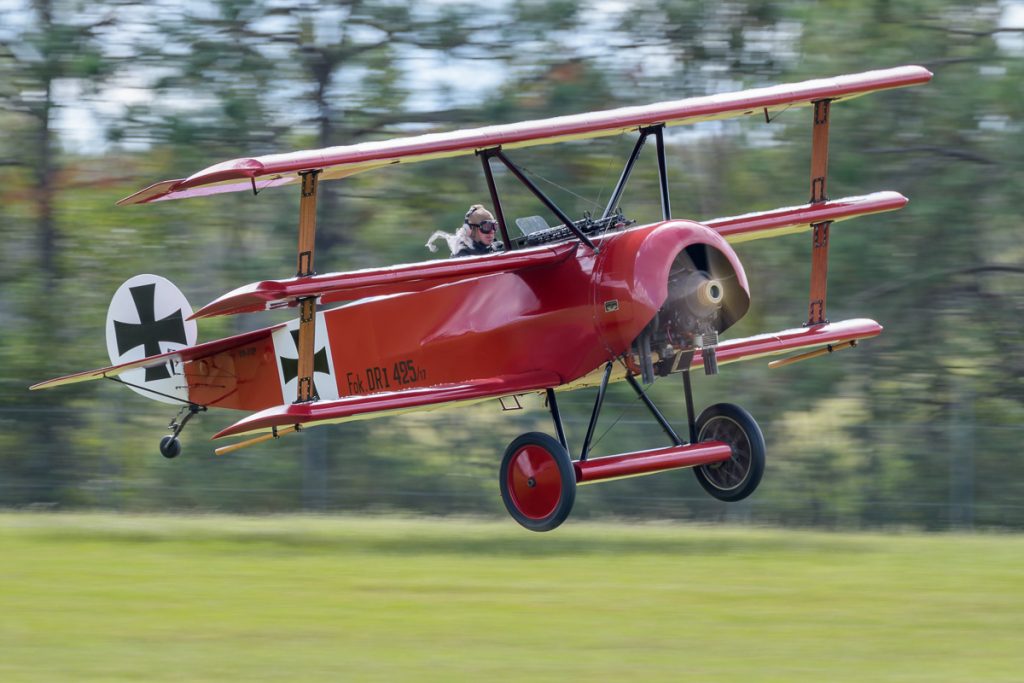On the weekend of 21st and 22nd of April 2019 The Australian Vintage Aviation Society (TAVAS) staged the TAVAS Great War Flying Display 2018 airshow. The event was organised primarily to remember the day 100 years ago when the Red Baron Manfred von Richthofen was shot down and killed by allied troops. The weekend included static and flying displays of replica WW1 aircraft, WW2 and post-WW2 era aircraft, general aviation and F/A-18F Super Hornet and C-17 Globemaster III flying displays by the RAAF. In part one of a six-part series of articles covering the airshow, I will concentrate on the remembrance of the Red Baron’s last flight. In future posts I will go into more detail about other aircraft that were on display during my visit.
The Red Baron von Richthofen
Born in Prussia in 1892 into an affluent family, at age eleven he was sent to a military school. In 1911, he was became a commissioned officer in a Prussian army cavalry regiment. His regiment saw action early in WW1, with Richthofen earning the Iron Cross for courage under fire. When his regiment was consigned to logistics duties, he applied for transfer to the German Air Service which was granted in 1915. Initially he was assigned the role of reconnaissance observer, later earning his pilots’ wings and being transferred to serve under ace Oswald Boelcke in Jasta 2.
The Baron's legend grows
He recorded his first kill in September 1916 and by early 1917 was the highest-scoring living German ace with 16 confirmed kills. At that time he was given command of his own squadron, Jasta 11, which included his brother Lothar. He had his Albatros D.III fighter painted all red, leading to his famous moniker of “the Red Baron”. As his tally rose, he was granted command of Jagdgeschwader I, comprising four squadrons; many aircraft in the unit were painted in bright colour schemes, the pilots wanting to be seen by Allied aircraft as they wanted to engage the enemy. This led to Jagdgeschwader I being known by Allied pilots as “the Flying Circus”. Late in 1917 Richthofen received a Fokker DR.1 triplane, the aircraft he would so famously be known by although he achieved only 19 of his total of 80 kills in this aircraft.
The final flight of the Red Baron
On 21st April 1918 his squadron was involved in a battle with British aircraft over France. Richthofen followed a British aircraft low over the trenches, pursued by Canadian Arthur “Roy” Brown. The Red Baron was hit by a .303 caliber machine gun bullet during this melee, wounding him in the heart and lungs. He managed to perform a crash landing in which the aircraft was largely undamaged, before succumbing to his wounds and dying in the cockpit. While Brown was credited with the kill, many years later forensic research has concluded that Australian anti-aircraft gunner SGT Cedric Popkin was the most likely person to have fired the fatal shot. In such high regard was he held by the Allies, he was given a full military burial, conducted by No. 3 Squadron Australian Flying Corps. When the war ended, the Red Baron held the most aerial victories of either side with 80 confirmed kills.
The TAVAS Red Baron Display
At 11am on Saturday 21st April 2018, 100 years to the day and time, TAVAS pilots took off for a re-enactment of the final flight of the Red Baron. Their replica Fokker DR.1 Triplane VH-FXP took off, pursued by their replica Bristol F.2B Fighter VH-IIZ to represent the aircraft of Canadian Roy Brown.
DR.1 Triplane VH-FXP took off, pursued by their replica Bristol F.2B Fighter VH-IIZ to represent the aircraft of Canadian Roy Brown. The pair performed a mock aerial battle, circling the airfield several times with each appearing to get the upper hand on the other.
Meanwhile, a group of military re-enactors dressed in period uniform represented the Australian anti-aircraft gunners on the ground, firing (blank rounds) at the Barons’ aircraft.
The soldiers fired a few volleys at the Baron while the Bristol Fighter chased him around the sky. Eventually the Fokker pilot performed an emergency landing as the von Richthofen had 100 years ago. The Fokker came to a stop and the Australian troops rushed to the aircraft capture the fallen enemy.
This was a well directed display, with two wonderful old aircraft in mock battle and period actors complimenting the show.
Other Information
Location
The TAVAS museum is located at Caboolture Aerodrome, around 50Km north of Brisbane, Queensland, Australia. For more information on their collection of World War 1 replica aircraft, visit the TAVAS museum website.
References
- Brigham Young University – The Death of Manfred von Richthofen: Who fired the fatal shot? by Dr M. Geoffrey Miller
- History.com – Red Baron
- TAVAS Museum – Fokker DR.I
























